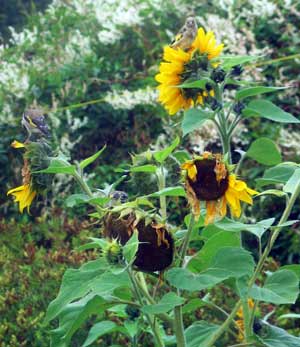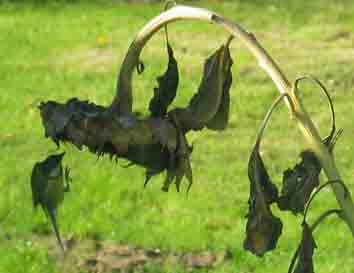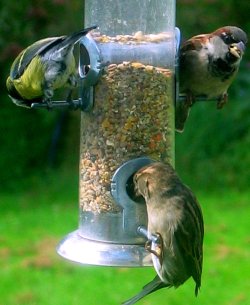How to Grow Sunflowers for Birds
Here's how to grow sunflowers for your garden or yard.
Growing sunflowers at home is really quite easy. You just need warm, moist soil and a good collection of sunflower seeds.

Picture above: Sunflowers with visiting goldfinches
Sunflowers act as a bird magnet in autumn and look wonderful in the height of summer. If you can, grow sunflowers at home to help the birds as well as give yourself a wonderful display of colour.
You can buy all kinds of exotic varieties of sunflower in the gardening shops butif you don't care about growing giants or creating a multi-coloured display, you can just sow sunflower seeds which have been grown for the birds. I've done this and they produced lots of medium sized sunflowers. Usually these seeds grown as bird food will germinate - but test out a few before you commit to this as you don't want to be disappointed, especially if you are growing them with your children.
Growing sunflowers with children is usually very rewarding as the results are so dramatic. When children are involved it makes sense to include at least some of the giant varieties. It's also great watching garden birds flock to the larger headed types - you can have a lot of fun watching them sway about on the seed heads. Giant sunflowers often carry on looking rather magnificent even after all the seeds have gone and the stalks have dried out.
The right soil for growing sunflowers
Growing sunflowers for the birds will result in a lot of flowers for you, too. Add to the variety by including a few of the more exotic colours now available. Heirloom varieties such as these can work well.
Prepare the ground in late March or April, when the soil has warmed some and frosts are finished. Exactly when this is will depend upon where you are. Moist rich soil is best.
Place your sunflower seeds in the earth and push them in to a depth of around a centimeter or two, depending on the size of seed. Give the sunflowers a little room by planting them a few inches apart. You can always thin them later if they all germinate.
Firm down the soil and give them a liberal amount of water. This helps the seed be in proper contact with the soil.
Plant plenty! You can always give spare plants away and there are sure to be some casualties. Some seeds won't germinate and some will be eaten by birds or rodents.
Slugs can be a problem. One solution is to plant your sunflower seeds in tubes - old toilet roll inners are almost ideal. Slugs are rather good at slicing straight through the stems of young sunflower seedlings! You can also add tubes after transplanting if you start growing your sunflowers in pots.
If you can get away with growing sunflowers without surrounding protection, they do tend to grow faster, I believe. There is almost certain to be some restriction involved in being placed inside tubing. Copper wire can also act as a slug deterrent.
How to grow sunflowers:
Growing sunflowers on to maturity
As your sunflowers grow on, you might find it worth staking them to prevent wind damage. Another approach that minimizes staking is to grow sunflowers in blocks, so that they help protect each other from the wind.
Not surprisingly, they like full sun! Growing sunflowers in the shade will have limited success.
Once they start growing, there are usually few problems. As they are large, robust plants they can usually cope with a few weeds around them but it's better to keep them reasonably clear, of course. Accidental damage is the main danger, as stems can snap quite easily.
How to grow sunflowers inside
Not really an option! Growing sunflowers inside might be possible if you have a large conservatory. I haven't tried this so far.
But, you can start off sunflowers inside. This avoids the problems of sudden frosts and the predatory snail or slug.
Scatter seeds thinly in a deep seed tray filled with growing medium. Cover them with soil or potting compost and firm it down. The seeds should be 1-2cms below the soil surface.
Water reasonably well and cover the tray with paper until germination occurs.
Thin them out and pot on into 3 inch pots as soon as they are big enough to handle.
Alternatively, you can start them off in three inch pots - or larger. Put either one or two seeds in each pot.
How to grow sunflowers:
Avoiding "leggy" sunflower seedlings
Keep a good look out for them becoming too "leggy" through lack of light. Even if you think your windowsill is quite a sunny spot, it can never compare with outside conditions, where plants obtain light from all around. Light bounces off other surrounding objects and this makes photosynthesis much more efficient in outdoor conditions.
Light through a window is far more one-sided. You will need to turn the developing seedlings around every day or two to stop them bending themselves towards the light and so becoming lop-sided.
If your sunflowers are becoming too tall and weak, put them outside for at least the warmest part of the day. If conditions are too cold, you could try surrounding them on the north side with tin foil; this will help them to collect more light. Get them out into a cold frame or greenhouse as soon as conditions allow.
Harden them off* before planting them outside. Watch out for late frosts. It's better to wait until all danger of frost has passed and the weather is mild and not windy. Water them well and firm them gently into the hole when planting out, making sure that the roots have enough room.
*Hardening off is the process of accustoming plants to cooler outdoor conditions. It's generally good to do this gradually.

Picture: Growing sunflowers is very rewarding because they looks so great. Later in the year they feed the birds and you can enjoy their acrobatic displays! The tit in this photo was practically hovering beneath the sunflower head.
Return from How to Grow Sunflowers back to Organic Gardening
Greenfootsteps Home - for more easy green living ideas
How to Grow Sunflowers for the Birds,
Copyright Greenfootsteps.com 2014
Please do not copy without seeking permission.
| Tweet |

| Tweet |

On other pages

Homemade Bird Food is Easy and Fun for Kids
Growing Comfrey for Added Garden Fertility
Footprints
- an occasional e-zine from Greenfootsteps
If you would like to receive the e-zine, please just sign up below.






New! Comments
Have your say about what you just read! Leave me a comment in the box below.